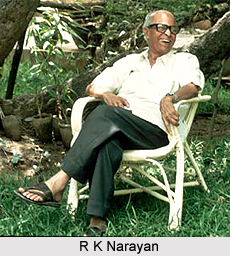 Mr Sampath - The Printer of Malgudi is a story of relationships. The novel portrays the journey of the central character "Mr Sampath who was the printer of the newspaper "The Banner". The intricacies of relationship, the falling in love and then experiencing the pain of love are perfectly limned in the novel. The central character "Mr. Sampath" is the driving force of the novel hence the story gels well with the apt title. Written in a loose style, which ideally reminds a comedy "The Printer Of Malgudi" unrolls the intricacies and significance of relationships, which actually bears a whole lot of meaning in the overall sustenance.
Mr Sampath - The Printer of Malgudi is a story of relationships. The novel portrays the journey of the central character "Mr Sampath who was the printer of the newspaper "The Banner". The intricacies of relationship, the falling in love and then experiencing the pain of love are perfectly limned in the novel. The central character "Mr. Sampath" is the driving force of the novel hence the story gels well with the apt title. Written in a loose style, which ideally reminds a comedy "The Printer Of Malgudi" unrolls the intricacies and significance of relationships, which actually bears a whole lot of meaning in the overall sustenance.
R K Narayan is known as a famous short story teller. His scholarly work starting from `Swami and friends` and during the whole journey he has written many masterpieces that still mark his position in the world literates. Born on 1906 at Madras i.e. today`s Chennai R. K. Narayan was very simple at his thoughts. He rarely addresses any political issues or high philosophy of life in any one of his write-ups. He writes with humor and also with full grace. A fictional town named Malgudi has come up in many of his writings. Malgudi, its inhabitants and their life story were the principal matter of his literature. Narayan is a classic teller of tales. From his pieces different aspects of life gets clearer vision. R. K. Narayan was not renowned as a writer from the very beginning. His popularity came slowly. He was lacking some sort of confidence. He never had the trappings of a high profile author, and was very shy of literary lunches and such gatherings. He remains engrossed with his characters and his fantasyland. US scholar Graham green supported him a lot and with his encouragement "Swami and his Friend" got published after which Narayan never looked back in his writing career.
Synopsis:
As other works of Narayan `Mr Sampath-the printer of Malgudi` also has a very simple storyline. First published in 1949, this book is now regarded as a classic. This book deals with some serious subjects with an overlying story employing with a ridiculous style of comedy. The protagonist of this story is Srinivas. He is a passionate editor of a newspaper that is run by only one person. The name of the newspaper is `The Banner` and Mr Sampath is the printer there who shoulders the financial burden of the newspaper. In this schedule he also makes uninvited editorial comments. This relationship appears to work well for Srinivas until the paper closes down and Sampath invites his friend to join him in the world of cinema or movie making. Eventually Sampath falls in love with the heroin of the movie and this step makes his life difficult as well. Srinivas has his problem of over responsibility. Due to some unavoidable circumstances Srinivas leaves the studio and revive `the banner` with another printer. Sampath was not bothered about it. But at the loss of the lady, money, fame, wealth, and peace he comes back to Srinivas.
Mr Sampath - The Printer of Malgudi is published in USA edition by Heinemann and Michigan State Univ Pr while in UK edition it has been published by William Heinemann Ltd. The UK paperback editions were published by Vintage, Minerva, and Mandarin. Some Indian publication also published this bokk like Hind Pckt and Indian Thought Publication. Eyre and Spottiswood also published this book wtitten by R K Narayan.
Mr Sampath-The Printer of Malgudi reflects the calm style and well-defined characters, as well as some recklessness in its characters. Srinivas is a naive but likeable character whereas Mr Sampath is a `wide boy`. This book cannot be called as a comedy as it unfurls some relationships of life that carry a lot of meaning as a whole. The ending of this book is nicely rounded, as it is good to find that Sampath has learnt from his past mistakes and found his true niche in life.



















